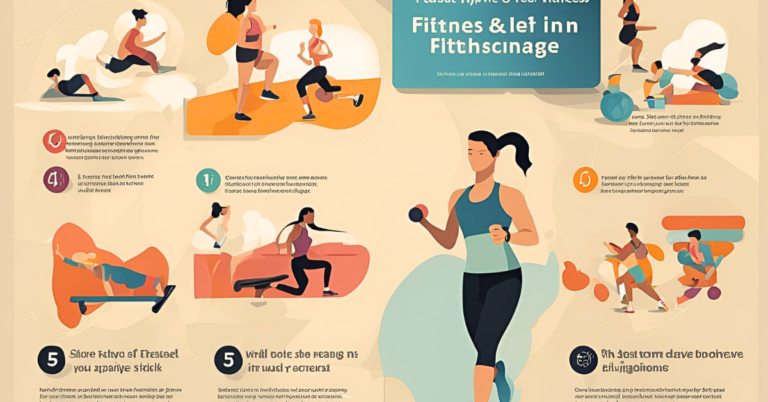Fitness is a multifaceted concept that goes beyond simple exercise routines. Understanding the five types of fitness is essential for creating a well-rounded exercise regimen that supports overall health and performance. Whether you’re a fitness enthusiast, a beginner, a personal trainer, or someone seeking a balanced lifestyle, this guide will help you navigate the different types of fitness and their benefits.
1. Cardiovascular Fitness
Cardiovascular fitness refers to the efficiency of your heart, lungs, and circulatory system in delivering oxygen to your muscles during sustained physical activity. This type of fitness is crucial for overall health and endurance.
Benefits:
- Improves Heart Health: Regular cardiovascular exercise helps reduce the risk of heart disease and high blood pressure.
- Increases Stamina: Enhances your ability to sustain physical activities for longer periods.
- Boosts Mood: Cardiovascular workouts release endorphins, which can help alleviate stress and improve your mood.
Examples:
- Running or Jogging
- Cycling
- Swimming
- Rowing
Tips: Aim for at least 150 minutes of moderate-intensity or 75 minutes of high-intensity cardiovascular exercise per week.
2. Strength Training
Strength training, also known as resistance training, focuses on building muscle strength and endurance. This type of fitness is vital for improving muscle mass, bone density, and metabolic rate.
Benefits:
- Enhances Muscle Tone: Strength training helps build and maintain muscle mass.
- Boosts Metabolism: Increased muscle mass leads to a higher resting metabolic rate.
- Improves Functional Strength: Aids in everyday tasks and activities.
Examples:
- Weightlifting
- Bodyweight Exercises (e.g., push-ups, squats)
- Resistance Band Exercises
Tips: Incorporate strength training exercises at least two days a week, targeting all major muscle groups.
3. Flexibility and Mobility
Flexibility and mobility focus on the range of motion in your joints and muscles. This type of fitness is essential for preventing injuries, improving posture, and enhancing overall physical performance.
Benefits:
- Increases Range of Motion: Helps improve flexibility and reduces stiffness.
- Enhances Posture: Aids in maintaining proper alignment and posture.
- Prevents Injuries: Reduces the risk of injuries by improving muscle and joint flexibility.
Examples:
- Stretching Exercises
- Yoga
- Pilates
Tips: Include flexibility exercises into your routine at least 2-3 times per week, ideally after your workouts when your muscles are warm.
To know How Does Mental Health Affect a Person? Please read this.
4. Balance and Stability
Balance and stability training focuses on improving your body’s ability to maintain equilibrium and control movements. This type of fitness is particularly important for injury prevention and overall functional fitness.
Benefits:
- Improves Coordination: Enhances your ability to perform complex movements with precision.
- Enhances Core Strength: Strengthens the muscles around your core, which is vital for stability.
- Reduces Fall Risk: Helps prevent falls and injuries, especially in older adults.
Examples:
- Balance Board Exercises
- Stability Ball Workouts
- Single-Leg Stands
Tips: Incorporate balance and stability exercises into your routine 2-3 times per week to improve overall functional fitness.
5. Functional Fitness
Functional fitness focuses on exercises that mimic everyday activities, enhancing your ability to perform daily tasks with ease. This type of fitness emphasizes movements that improve your strength, flexibility, and balance in real-life scenarios.
Benefits:
- Improves Daily Functioning: Enhances your ability to perform daily activities more efficiently.
- Reduces Injury Risk: Helps prevent injuries by strengthening muscles and improving coordination.
- Supports Overall Health: Integrates multiple types of fitness, providing comprehensive benefits.
Examples:
- Functional Training Circuits
- Bodyweight Exercises (e.g., lunges, squats)
- Resistance Training with Functional Movements
Tips: Focus on exercises that incorporate multiple muscle groups and mimic real-life movements.
Conclusion
Understanding and incorporating the five types of fitness—cardiovascular, strength training, flexibility and mobility, balance and stability, and functional fitness—into your exercise routine can help you achieve a balanced and effective workout regimen. Whether you’re a fitness enthusiast, a beginner, or a personal trainer, integrating these fitness types into your routine will lead to improved health, performance, and overall well-being.
Start incorporating these fitness types into your routine today and take the first step towards a healthier, more balanced life. Remember, a well-rounded fitness plan not only enhances your physical health but also supports mental and emotional well-being. Keep moving, stay motivated, and enjoy the journey to a fitter you!
FAQ
- What are the 5 key types of fitness?
- Understanding the five key types of fitness—cardiovascular, strength training, flexibility and mobility, balance and stability, and functional fitness—can help you create a balanced workout routine that supports overall health.
- How can I incorporate all 5 types of fitness into my routine?
- To incorporate all five types of fitness into your routine, include cardiovascular exercises, strength training sessions, flexibility exercises, balance and stability workouts, and functional movements throughout your week for a comprehensive approach to fitness.
- Why is it important to focus on different types of fitness?
- Focusing on different types of fitness ensures a well-rounded exercise regimen that improves overall health, enhances performance, prevents injuries, and supports a balanced lifestyle by targeting various aspects of physical fitness.



1 Comment
Pingback: আত্মবিশ্বাস বাড়ানোর প্রমাণিত পদ্ধতি: আজই চেষ্টা করুন